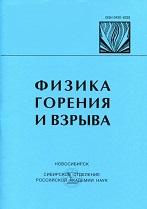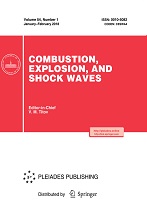|
This article is cited in 29 scientific papers (total in 29 papers)
Combustion characteristics of a hydroxylammonium nitrate based liquid propellant. Combustion mechanism and application to thrusters
T. Katsumia, H. Kodamaa, T. Matsuob, H. Ogawac, N. Tsuboic, K. Horic
a University of Tokyo, Tokyo, Japan
b Mitsubishi Heavy Industries, Ltd., Nagasaki, Japan
c Institute of Space and Astronautical Sciences, Kanagawa, Japan
Abstract:
A new composition of hydroxylammonium nitrate based solution containing ammonium nitrate, methanol, and water was developed for monopropellant in a reaction control system (RCS) as an alternative to conventional hydrazine. In comparison with hydrazine, this solution has a 20% higher specific impulse, 1.4 times higher density, and lower freezing point and toxicity. The linear burning rate of the solution is moderate at the operating pressures of RCS thrusters. It was found that the linear burning rate had some characteristics whose mechanisms had not been understood. The combustion mechanism of this solution was investigated. The burning behavior was observed using a medium speed camera, and a temperature profile for the combustion wave was measured with a 2.5 $\mu$m diameter thermocouple. From these results, the instability of the liquid-gas interface may trigger a sudden increase in the burning rate, and methanol was found to be effective in reducing the bubble growth rate in the solution. The reactivity of several catalysts was evaluated in an open-cup test, and the S405 catalyst for hydrazine showed the best performance among them. Thruster tests were conducted using the S405 catalyst with variation in the propellant mass flow rate, catalyst bed configuration, and length-to-diameter ratio of the combustor. As a result, parameters were determined that ensured long operating time. The model thruster operated stably for up to 100 sec with a specific impulse $I_{sp}$ = 240 sec, which corresponds to a 90% efficiency.
Keywords:
hydroxylammonium nitrate, methanol, burning rate, transition mechanism, hydrodynamic instability, monopropellant, RCS, thruster.
Received: 25.10.2008
Citation:
T. Katsumi, H. Kodama, T. Matsuo, H. Ogawa, N. Tsuboi, K. Hori, “Combustion characteristics of a hydroxylammonium nitrate based liquid propellant. Combustion mechanism and application to thrusters”, Fizika Goreniya i Vzryva, 45:4 (2009), 109–120; Combustion, Explosion and Shock Waves, 45:4 (2009), 442–453
Linking options:
https://www.mathnet.ru/eng/fgv1322 https://www.mathnet.ru/eng/fgv/v45/i4/p109
|


|





 Contact us:
Contact us: Terms of Use
Terms of Use
 Registration to the website
Registration to the website Logotypes
Logotypes








 Citation in format
Citation in format 
